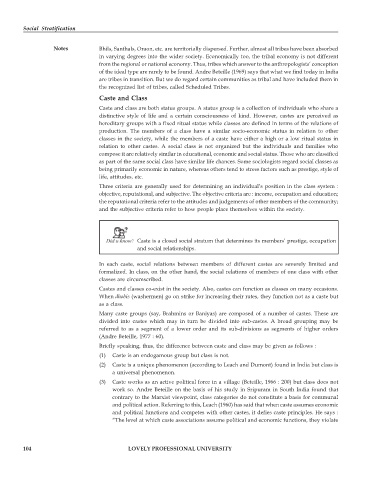Page 109 - DSOC202_SOCIAL_STRATIFICATION_ENGLISH
P. 109
Social Stratification
Notes Bhils, Santhals, Oraon, etc. are territorially dispersed. Further, almost all tribes have been absorbed
in varying degrees into the wider society. Economically too, the tribal economy is not different
from the regional or national economy. Thus, tribes which answer to the anthropologists’ conception
of the ideal type are rarely to be found. Andre Beteille (1969) says that what we find today in India
are tribes in transition. But we do regard certain communities as tribal and have included them in
the recognized list of tribes, called Scheduled Tribes.
Caste and Class
Caste and class are both status groups. A status group is a collection of individuals who share a
distinctive style of life and a certain consciousness of kind. However, castes are perceived as
hereditary groups with a fixed ritual status while classes are defined in terms of the relations of
production. The members of a class have a similar socio-economic status in relation to other
classes in the society, while the members of a caste have either a high or a low ritual status in
relation to other castes. A social class is not organized but the individuals and families who
compose it are relatively similar in educational, economic and social status. Those who are classified
as part of the same social class have similar life chances. Some sociologists regard social classes as
being primarily economic in nature, whereas others tend to stress factors such as prestige, style of
life, attitudes, etc.
Three criteria are generally used for determining an individual’s position in the class system :
objective, reputational, and subjective. The objective criteria are : income, occupation and education;
the reputational criteria refer to the attitudes and judgements of other members of the community;
and the subjective criteria refer to how people place themselves within the society.
Caste is a closed social stratum that determines its members’ prestige, occupation
and social relationships.
In each caste, social relations between members of different castes are severely limited and
formalized. In class, on the other hand, the social relations of members of one class with other
classes are circumscribed.
Castes and classes co-exist in the society. Also, castes can function as classes on many occasions.
When dhobis (washermen) go on strike for increasing their rates, they function not as a caste but
as a class.
Many caste groups (say, Brahmins or Baniyas) are composed of a number of castes. These are
divided into castes which may in turn be divided into sub-castes. A broad grouping may be
referred to as a segment of a lower order and its sub-divisions as segments of higher orders
(Andre Beteille, 1977 : 60).
Briefly speaking, thus, the difference between caste and class may be given as follows :
(1) Caste is an endogamous group but class is not.
(2) Caste is a unique phenomenon (according to Leach and Dumont) found in India but class is
a universal phenomenon.
(3) Caste works as an active political force in a village (Beteille, 1966 : 200) but class does not
work so. Andre Beteille on the basis of his study in Sripuram in South India found that
contrary to the Marxist viewpoint, class categories do not constitute a basis for communal
and political action. Referring to this, Leach (1960) has said that when caste assumes economic
and political functions and competes with other castes, it defies caste principles. He says :
“The level at which caste associations assume political and economic functions, they violate
104 LOVELY PROFESSIONAL UNIVERSITY

